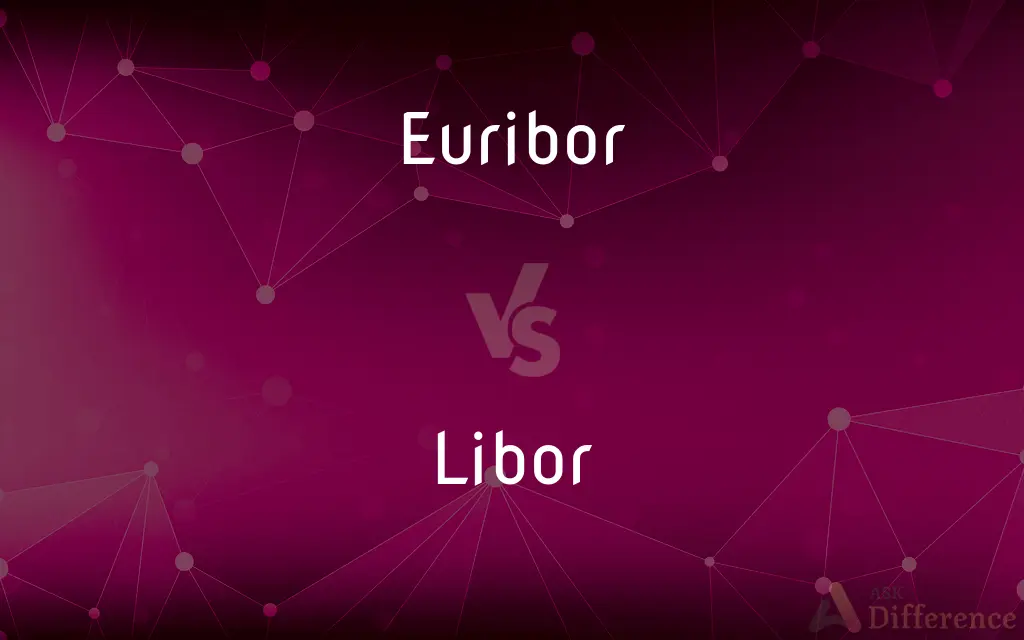EURIBOR vs. LIBOR — What's the Difference?
Edited by Tayyaba Rehman — By Maham Liaqat — Updated on March 15, 2024
EURIBOR reflects the interest rates at which Eurozone banks lend to each other, while LIBOR indicates the rates for short-term loans in the international banking market in various currencies.

Difference Between EURIBOR and LIBOR
Table of Contents
ADVERTISEMENT
Key Differences
EURIBOR (Euro Interbank Offered Rate) is a daily reference rate based on the averaged interest rates at which Eurozone banks offer to lend unsecured funds to other banks in the euro wholesale money market (or interbank market). It plays a crucial role in the European financial markets, influencing mortgages, savings, and loans. LIBOR (London Interbank Offered Rate), on the other hand, was a benchmark interest rate at which major global banks lend to one another in the international interbank market for short-term loans. It covered multiple currencies, including the US Dollar, British Pound, Japanese Yen, and others, serving as a global reference point for short-term interest rates.
EURIBOR is specifically tied to the Euro currency, reflecting the health and stability of the European banking sector and the broader economy of the Eurozone. LIBOR, whereas, was used worldwide, affecting a vast array of financial instruments and contracts across different currencies, making it a cornerstone of the global financial system.
The calculation of EURIBOR is based on contributions from a panel of banks within the Eurozone, ensuring it accurately represents the cost of euro-denominated interbank lending. Conversely, LIBOR was determined through submissions by a panel of banks from around the world, estimating the rates at which they expected to borrow from one another in various currencies, before its phase-out began in favor of more reliable benchmarks.
EURIBOR is essential for the pricing of Euro-denominated financial products, including loans, savings accounts, and mortgages within Europe. LIBOR’s influence was broader, impacting global financial products and contracts, from complex derivatives to consumer loans, until its transition to alternative rates like SOFR (Secured Overnight Financing Rate) for the US dollar began due to concerns over its reliability and the integrity of its calculation method.
The governance and oversight of EURIBOR have been strengthened in recent years to enhance transparency and reliability, following the financial scandals that affected the credibility of LIBOR. The transition away from LIBOR to more robust and transparent rates seeks to mitigate the risks associated with benchmark manipulation and ensure a more stable and trustworthy reference rate system.
ADVERTISEMENT
Comparison Chart
Definition
Euro Interbank Offered Rate: the interest rate at which Eurozone banks lend to each other.
London Interbank Offered Rate: the global interest rate for banks lending to each other.
Currency
Euro (EUR) only.
Multiple currencies including USD, GBP, EUR, JPY, and CHF.
Geographic Scope
Eurozone.
Global.
Purpose
Reflects the cost of euro-denominated interbank lending.
Served as a global benchmark for short-term interest rates.
Calculation
Based on submissions from a panel of Eurozone banks.
Determined by submissions from a global panel of banks.
Impact
Influences Eurozone mortgages, savings, and loans.
Affected a wide range of financial instruments worldwide.
Transition
Remains a key rate in the Eurozone.
Phased out in favor of alternative benchmarks due to reliability concerns.
Compare with Definitions
Euribor
The average interest rate at which Eurozone banks lend to one another.
The increase in EURIBOR rates has led to higher mortgage payments for homeowners in the Eurozone.
Libor
The benchmark interest rate for short-term loans in the international banking market.
LIBOR was once the foundation for pricing trillions of dollars in financial transactions.
Euribor
Reflects the cost of borrowing euros in the interbank market.
As EURIBOR rises, the cost of corporate borrowing in the euro also increases.
Libor
Served as a reference for a wide range of financial instruments.
From mortgages to student loans, LIBOR influenced the cost of borrowing worldwide.
Euribor
Influences financial products and contracts within the Eurozone.
Many variable-rate loans in Europe are tied to EURIBOR.
Libor
Has been phased out due to concerns over its reliability.
The transition away from LIBOR to alternative rates aims to enhance the benchmark's integrity.
Euribor
A key reference rate for the Euro currency area.
Savings accounts' interest rates in Europe are often indexed to EURIBOR.
Libor
Was used globally across various currencies.
LIBOR rates were published for five major currencies, affecting global financial markets.
Euribor
Is calculated daily from a panel of banks.
EURIBOR rates are updated every morning after the panel banks submit their data.
Libor
Was determined by a panel of major global banks.
The daily LIBOR rates were an average of panel banks' estimated borrowing costs.
Euribor
The Euro Interbank Offered Rate (Euribor) is a daily reference rate, published by the European Money Markets Institute, based on the averaged interest rates at which Eurozone banks offer to lend unsecured funds to other banks in the euro wholesale money market (or interbank market). Prior to 2015, the rate was published by the European Banking Federation.
Libor
The London Inter-bank Offered Rate is an interest-rate average calculated from estimates submitted by the leading banks in London. Each bank estimates what it would be charged were it to borrow from other banks.
Common Curiosities
Can EURIBOR and LIBOR rates differ significantly?
Yes, EURIBOR and LIBOR rates can differ due to their different geographical focus, currencies covered, and the panel of banks contributing to the rates.
What is EURIBOR used for?
EURIBOR is used as a reference rate for determining the interest rates of various financial products and contracts within the Eurozone, including mortgages and loans.
What are the alternatives to LIBOR?
Alternatives to LIBOR include SOFR for the US dollar, SONIA for the British pound, and EURIBOR remains in use for the Euro.
What happens to financial products tied to LIBOR after its phase-out?
Financial products tied to LIBOR are transitioning to alternative reference rates, with contractual fallback provisions to ensure a smooth transition.
How is EURIBOR calculated?
EURIBOR is calculated based on the average interest rates at which Eurozone banks offer to lend unsecured funds to other banks in the euro wholesale money market.
Who oversees EURIBOR?
EURIBOR is overseen by the European Money Markets Institute (EMMI), ensuring transparency and reliability in its calculation.
How did LIBOR affect consumers?
LIBOR influenced the interest rates on consumer products like mortgages, student loans, and other loans, impacting the borrowing costs for individuals globally.
Why was LIBOR phased out?
LIBOR was phased out due to concerns over its reliability and the integrity of its calculation method, following manipulation scandals.
How often are EURIBOR and LIBOR rates updated?
EURIBOR rates are updated daily based on bank submissions, while LIBOR rates were also updated daily before its phase-out began.
Is EURIBOR reliable?
EURIBOR has undergone reforms to enhance its governance and calculation methodology, aiming to maintain its reliability as a benchmark rate.
Share Your Discovery

Previous Comparison
Threw vs. Thrown
Next Comparison
Porch vs. StoopAuthor Spotlight
Written by
Maham LiaqatEdited by
Tayyaba RehmanTayyaba Rehman is a distinguished writer, currently serving as a primary contributor to askdifference.com. As a researcher in semantics and etymology, Tayyaba's passion for the complexity of languages and their distinctions has found a perfect home on the platform. Tayyaba delves into the intricacies of language, distinguishing between commonly confused words and phrases, thereby providing clarity for readers worldwide.















































